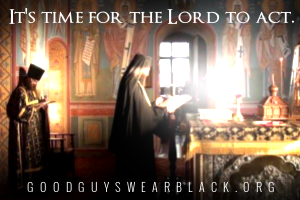by Fr. Alexander Schmemann
 Our father, Protopresbyter Alexander Schmemann, (d. 1983) was a prominent 20th century Orthodox Christian priest, theologian, and writer.
Our father, Protopresbyter Alexander Schmemann, (d. 1983) was a prominent 20th century Orthodox Christian priest, theologian, and writer.
He taught at St. Vladimir Theological Seminary in Crestwood, NY and at St. Sergius Orthodox Theological Institute in Paris, France. His writings have been very influential in contemporary Orthodoxy, and have been translated into many languages.
The Third Sunday of Lent is called “The Veneration of the Cross.”
At the Vigil on that day, after the Great Doxology, the Cross is brought in a solemn procession to the center of the church and remains there for the entire week – with a special rite of veneration following each service. It is noteworthy that the theme of the Cross which dominates the hymnology of that Sunday is developed in terms not of suffering but of victory and joy.
More than that, the theme – songs (hirmoi) of the Sunday Canon are taken from the Paschal Service – “The Day of the Resurrection” – and the Canon is a paraphrase of the Easter Canon. The meaning of all this is clear. We are in Mid – Lent.
On the one hand, the physical and spiritual effort, if it serious and consistent, begins to be felt, its burden becomes more burdensome, our fatigue more evident. We need help and encouragement. On the other hand, having endured this fatigue, having climbed the mountain up to this point, we begin to see the end of our pilgrimage, and the rays of Easter grow in their intensity.
Lent is our self – crucifixion, our experience, limited as it is, of Christ’s commandment heard in the Gospel lesson of that Sunday:
“If any man would come after me, let him deny himself and take up his cross and follow me” (Mark 8:34).
But we can not take up our cross and follow Christ unless we have His Cross which He took up in order to save us. It is His Cross, not ours, that saves us. It is His Cross that gives not only meaning but also power to others.
This is explained to us in the synaxarion of the Sunday of the Cross: – On this Sunday, the third Sunday of Lent, we celebrate the veneration of the honorable – and Life -Giving Cross, and for this reason: inasmuch as in the forty days of fasting we – in a way crucify ourselves…and become bitter and despondent and failing, the – Life -Giving Cross is presented to us for refreshment and assurance, for remembrance of – our Lord’s Passion, and for comfort…
We are like those following a long and cruel path – who become tired, see a beautiful tree and many leaves, sit in its shadow and rest for – a while and then, as if rejuvenated, continue their journey; likewise today, in the – time of fasting and difficult journey and effort, the Life – Giving Cross was planted in – our midst by the holy fathers to give us rest and refreshment, to make us light and – courageous for the remaining task…
Or, to give another example: when a king is coming, – at first his banner and symbols appear, then he himself comes glad and rejoicing about – his victory and filling with joy those under him; likewise, our Lord Jesus Christ, who – is about to show us His victory over death, and appear to us in the glory of the – Resurrection Day, is sending to us in advance His scepter, the royal symbol – the – Life – Giving Cross – and it fills us with joy and makes us ready to meet, inasmuch as it – is possible for us, the King himself, and to render glory to His victory…
All this in – the midst of Lent which is like a bitter source because of its tears, because also of – its efforts and despondency…but Christ comforts us who are as it were in a desert – until He shall lead us up to the spiritual Jerusalem by His Resurrection…for the – Cross is called the Tree of Life, it is the tree that was planted in Paradise, and for – this reason our fathers have planted it in the midst of Holy Lent, remembering both – Adam’s bliss and how he was deprived of it, remembering also that partaking of this – Tree we no longer die but are kept alive…
